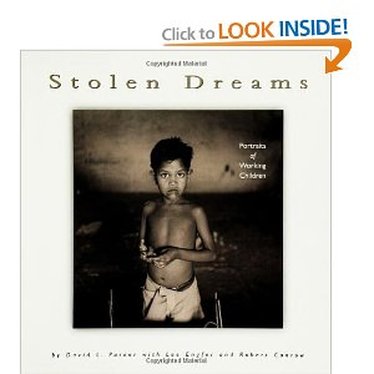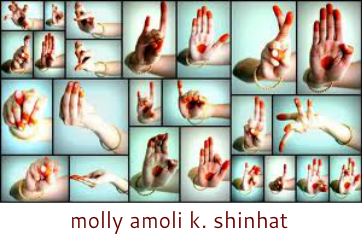Portraits of the World's Working Children
Stolen Dreams : David L. Parker
Canadian Museum of Civilization

Cover of David Parker's book, courtesy Amazon.com
With her small scaly scab-encrusted hands raised to her face and an out of focus carpet in the background, the five-year-old Nepalese girl's facial expression belies her age. The toughest moments in her day are not about choosing a crayon colour but about mustering the will to continue working with advanced dermatitis. She will be tying knots in the carpet for another 10-12 hours today.
Some may find this a bit too blunt as photographic statements go, but what is subtle about life for this little girl?
About seventy 16" x 20" black and white photographs by American labour medicine specialist David L. Parker show other such moments in the lives of a few of the world's 250 million working children.
Merging his critique of child labour with a harnessing of aesthetics, this photograph is one of Parker's strongest. Given his non-photographic background, it's not a leap made in all the images.
Photojournalists have been walking along this road for at least one hundred years. From 1971-1973, for instance, the American W. Eugene Smith laboured on his last major essay for Life Magazine. He was photographing the appalling human deformations resulting from mercury poisoning by Chisso Corporation in the waters of Minamata, a Japanese fishing village. For his efforts to document the impact on the local fishing community, he was brutally beaten so ferociously that in 1974 he temporarily lost his eyesight. The powerful and magnificent photographs he took, particularly of children, speak to the evils of pollution and its shattering irreversible consequences.
What Parker lacks in photographic technique and understanding of light, he makes up for in compassion. Traveling in the United States, Mexico, Thailand, Nepal, Bangladesh, India, Turkey, Morocco, India and Indonesia, he photographed children working in a range of areas, including the sex industry, mining, manufacturing and the circus.
Parker fortuitously sees and unmasks alignments underscoring awful working conditions and growing divides between children in the North and children in the South. Garbage picker with Barbie doll, Acapulco, Mexico 1996shows a little girl, running through the haze, dragging a broken toy car behind her. Atop her head, she balances some books, a game and a tattered Barbie doll. In the caption, we learn that "children scavenge through the dump where they find their toys and help their parents."
Occasionally Parker dips into the ancient treasure house of stereotypes of "poor little coloured children". He photographs a circus worker performing a contortion seemingly only for the purpose of the photograph. Was the contortion entirely necessary? The labels also detract from Parker's aim, using "garbage picker" instead of the child's name, for instance, to identify a child tends to create distance and de-humanize the subject.
Despite its shortcomings, Stolen Dreams constitutes a stinging indictment of the exploitation of children. Parker's own "mistakes" raise more questions about how to inform the "Haves" of the world about this exploitation and help bring an end to what for many children has become a living nightmare.
Published in The Ottawa Xpress
Some may find this a bit too blunt as photographic statements go, but what is subtle about life for this little girl?
About seventy 16" x 20" black and white photographs by American labour medicine specialist David L. Parker show other such moments in the lives of a few of the world's 250 million working children.
Merging his critique of child labour with a harnessing of aesthetics, this photograph is one of Parker's strongest. Given his non-photographic background, it's not a leap made in all the images.
Photojournalists have been walking along this road for at least one hundred years. From 1971-1973, for instance, the American W. Eugene Smith laboured on his last major essay for Life Magazine. He was photographing the appalling human deformations resulting from mercury poisoning by Chisso Corporation in the waters of Minamata, a Japanese fishing village. For his efforts to document the impact on the local fishing community, he was brutally beaten so ferociously that in 1974 he temporarily lost his eyesight. The powerful and magnificent photographs he took, particularly of children, speak to the evils of pollution and its shattering irreversible consequences.
What Parker lacks in photographic technique and understanding of light, he makes up for in compassion. Traveling in the United States, Mexico, Thailand, Nepal, Bangladesh, India, Turkey, Morocco, India and Indonesia, he photographed children working in a range of areas, including the sex industry, mining, manufacturing and the circus.
Parker fortuitously sees and unmasks alignments underscoring awful working conditions and growing divides between children in the North and children in the South. Garbage picker with Barbie doll, Acapulco, Mexico 1996shows a little girl, running through the haze, dragging a broken toy car behind her. Atop her head, she balances some books, a game and a tattered Barbie doll. In the caption, we learn that "children scavenge through the dump where they find their toys and help their parents."
Occasionally Parker dips into the ancient treasure house of stereotypes of "poor little coloured children". He photographs a circus worker performing a contortion seemingly only for the purpose of the photograph. Was the contortion entirely necessary? The labels also detract from Parker's aim, using "garbage picker" instead of the child's name, for instance, to identify a child tends to create distance and de-humanize the subject.
Despite its shortcomings, Stolen Dreams constitutes a stinging indictment of the exploitation of children. Parker's own "mistakes" raise more questions about how to inform the "Haves" of the world about this exploitation and help bring an end to what for many children has become a living nightmare.
Published in The Ottawa Xpress

